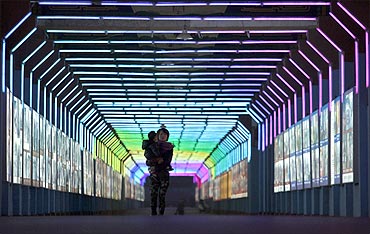 | « Back to article | Print this article |
This is Huaxi, China's richest village!
Huaxi village, set up in 1961, is China's richest village. It is also called the No.1 Village of China.
Here everyone lives in a villa and owns cars -- imported cars.
Image: New houses are seen at Huaxi village in Jiangsu province.
Photograph: Carlos Barria/Reuters
Click NEXT to read on . . .
This is Huaxi, China's richest village!
In this village of Huaxi, a booming market town of 36,000 in China's affluent eastern province of Jiangsu, every family has at least one house or villa, two cars and $250,000 in the bank.
Image: A row of new homes in Huaxi village.
Photograph: Carlos Barria/Reuters
Click NEXT to read on . . .
This is Huaxi, China's richest village!
The villagers homes/villas are of around 4,000 sq ft to 6,000 sq ft area.
The annual sales revenue of the village is around $30.78 billion.
Image: A man watches the Huaxi village from a vantage point.
Photograph: Carlos Barria/Reuters
Click NEXT to read on . . .
This is Huaxi, China's richest village!
One man is credited with turning around the fortunes of the village: Wu Renbao, who was the secretary of the village's local branch of the Communist Party. Read on to find out how he did it . . .
Image: A woman looks at jewellery in a shop in Huaxi village.
Photograph: Carlos Barria/Reuters
Click NEXT to read on . . .
This is Huaxi, China's richest village!
Wu Renbao adopted a set of policies that were an amalgam of free market economics and customary principles of communism.
Image: Lu Jianmin watches television inside her house in Huaxi village.
Photograph: Carlos Barria/Reuters
Click NEXT to read on . . .
This is Huaxi, China's richest village!
About 40 years ago, Wu Renbao, a farmer himself, propelled a movement which saw Huaxi transform itself from an agriculture-driven economy into an industrial powerhouse.
Image: A woman carrying a baby walks at a tourist area of Huaxi village.
Photograph: Carlos Barria/Reuters
Click NEXT to read on . . .
This is Huaxi, China's richest village!
The village built factories by the hundreds and the disciplined villagers, who all work seven days a week and take breaks only once in a while, soon realised the fruits of hard labour and smart transition from agriculture to industry.
Image: Workers wait for an elevator at the construction site of a high-rise building in Huaxi village.
Photograph: Carlos Barria/Reuters
Click NEXT to read on . . .
This is Huaxi, China's richest village!
The village itself is like no other Chinese village or city. It resembles a western suburb that has been just plucked from the American countryside and transplanted into China.
Image: An employee works at a clothes factory in Huaxi village.
Photograph: Carlos Barria/Reuters
Click NEXT to read on . . .
This is Huaxi, China's richest village!
Officials from elsewhere in China tour Huaxi to find out how this once sleepy village, with just 576 residents in the 1950s, is now so rich and why non-local businessmen would donate million-dollar factories to buy the privilege of a local residence permit.
Image: An employee works at a clothes factory in Huaxi village.
Photograph: Carlos Barria/Reuters
Click NEXT to read on . . .
This is Huaxi, China's richest village!
Huaxi Village has adhered to a path of 'relying on the collective economy and working for common prosperity', says People's Daily.
Image: An employee works at the Huaxi Iron and Company in Huaxi village.
Photograph: Carlos Barria/Reuters
Click NEXT to read on . . .
This is Huaxi, China's richest village!
Big items like villas and cars are distributed in a uniform way to the villagers here.
People do not have to pay for it as the village distributes this wealth.
Image: An employee works at the Huaxi Iron and Company in Huaxi village.
Photograph: Carlos Barria/Reuters
Click NEXT to read on . . .
This is Huaxi, China's richest village!
The construction and decoration are uniformly designed by the village, and also paid for by the village.
Image: Pollution is seen over an industrial area of Huaxi village.
Photograph: Carlos Barria/Reuters
Click NEXT to read on . . .
This is Huaxi, China's richest village!
Image: A woman holds a baby at a new housing area in Huaxi village.
Photograph: Carlos Barria/Reuters
Click NEXT to read on . . .
This is Huaxi, China's richest village!
Image: A man takes pictures of a tourist area in Huaxi village.
Photograph: Carlos Barria/Reuters
Click NEXT to read on . . .
This is Huaxi, China's richest village!
Image: A man walks in front of a painting of China's late chairman Mao Zedong in Huaxi village.
Photograph: Carlos Barria/Reuters














